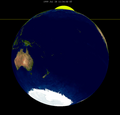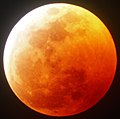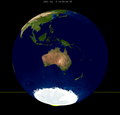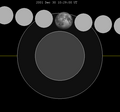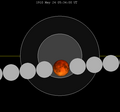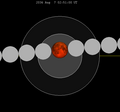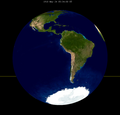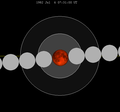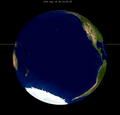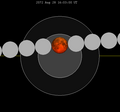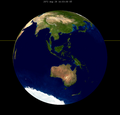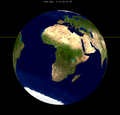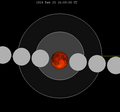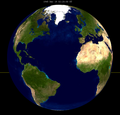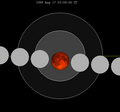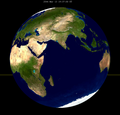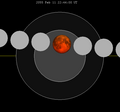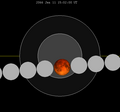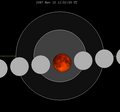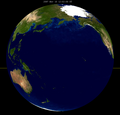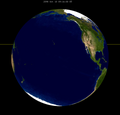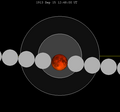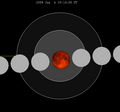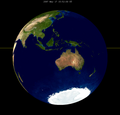July 2000 lunar eclipse
A total lunar eclipse occurred at the Moon’s descending node of orbit on Sunday, July 16, 2000,[1] with an umbral magnitude of 1.7684. It was a central lunar eclipse, in which part of the Moon passed through the center of the Earth's shadow. A lunar eclipse occurs when the Moon moves into the Earth's shadow, causing the Moon to be darkened. A total lunar eclipse occurs when the Moon's near side entirely passes into the Earth's umbral shadow. Unlike a solar eclipse, which can only be viewed from a relatively small area of the world, a lunar eclipse may be viewed from anywhere on the night side of Earth. A total lunar eclipse can last up to nearly two hours, while a total solar eclipse lasts only a few minutes at any given place, because the Moon's shadow is smaller. Occurring about 1.1 days after apogee (on July 15, 2000, at 11:30 UTC), the Moon's apparent diameter was smaller.[2] Totality lasted for 106 minutes and 25 seconds, the longest duration since 13 August 1859 (106 minutes and 28 seconds) and 3 May 459 (106 minutes and 32 seconds), and totality of this length won't occur again until 19 August 4753 (106 minutes and 35 seconds). This was the last and longest total lunar eclipse of the 20th century as well as the second longest and last of the second millennium. It was also the eighth longest total lunar eclipse on EclipseWise's Six Millennium Catalog of Lunar Eclipses which covers the years 3000 BCE to 3000 AD. The longest total lunar eclipse between the years 4000 BCE and 6000 CE took place on 31 May 318. Totality lasted 106 minutes and 36 seconds which is only 11 seconds longer than this one.[3] VisibilityThe eclipse was completely visible over Australia, Antarctica, and much of the Pacific Ocean, seen rising over Asia and eastern Africa and setting over western North and South America.[4]
Eclipse detailsShown below is a table displaying details about this particular lunar eclipse. It describes various parameters pertaining to this eclipse.[5]
Eclipse seasonThis eclipse is part of an eclipse season, a period, roughly every six months, when eclipses occur. Only two (or occasionally three) eclipse seasons occur each year, and each season lasts about 35 days and repeats just short of six months (173 days) later; thus two full eclipse seasons always occur each year. Either two or three eclipses happen each eclipse season. In the sequence below, each eclipse is separated by a fortnight. The first and last eclipse in this sequence is separated by one synodic month.
Related eclipsesEclipses in 2000
Metonic
Tzolkinex
Half-Saros
Tritos
Lunar Saros 129
Inex
Triad
Lunar eclipses of 1998–2002This eclipse is a member of a semester series. An eclipse in a semester series of lunar eclipses repeats approximately every 177 days and 4 hours (a semester) at alternating nodes of the Moon's orbit.[6] The penumbral lunar eclipses on March 13, 1998 and September 6, 1998 occur in the previous lunar year eclipse set, and the penumbral lunar eclipses on May 26, 2002 and November 20, 2002 occur in the next lunar year eclipse set.
Saros 129This eclipse is a part of Saros series 129, repeating every 18 years, 11 days, and containing 71 events. The series started with a penumbral lunar eclipse on June 10, 1351. It contains partial eclipses from September 26, 1531 through May 11, 1892; total eclipses from May 24, 1910 through September 8, 2090; and a second set of partial eclipses from September 20, 2108 through April 26, 2469. The series ends at member 71 as a penumbral eclipse on July 24, 2613. The longest duration of totality was produced by member 37 at 106 minutes, 24 seconds on July 16, 2000. All eclipses in this series occur at the Moon’s descending node of orbit.[7]
Eclipses are tabulated in three columns; every third eclipse in the same column is one exeligmos apart, so they all cast shadows over approximately the same parts of the Earth.
Tritos seriesThis eclipse is a part of a tritos cycle, repeating at alternating nodes every 135 synodic months (≈ 3986.63 days, or 11 years minus 1 month). Their appearance and longitude are irregular due to a lack of synchronization with the anomalistic month (period of perigee), but groupings of 3 tritos cycles (≈ 33 years minus 3 months) come close (≈ 434.044 anomalistic months), so eclipses are similar in these groupings.
Inex seriesThis eclipse is a part of the long period inex cycle, repeating at alternating nodes, every 358 synodic months (≈ 10,571.95 days, or 29 years minus 20 days). Their appearance and longitude are irregular due to a lack of synchronization with the anomalistic month (period of perigee). However, groupings of 3 inex cycles (≈ 87 years minus 2 months) comes close (≈ 1,151.02 anomalistic months), so eclipses are similar in these groupings.
Half-Saros cycleA lunar eclipse will be preceded and followed by solar eclipses by 9 years and 5.5 days (a half saros).[9] This lunar eclipse is related to two total solar eclipses of Solar Saros 136.
See alsoNotes
External links
Wikimedia Commons has media related to Lunar eclipse of 2000 July 16. |
|||||||||||||||||||||||||||||||||||||||||||||||||||||||||||||||||||||||||||||||||||||||||||||||||||||||||||||||||||||||||||||||||||||||||||||||||||||||||||||||||||||||||||||||||||||||||||||||||||||||||||||||||||||||||||||||||||||||||||||||||||||||||||||||||||||||||||||||||||||||||||||||||||||||||||||||||||||||||||||||||||||||||||||||||||||||||||||||||||||||||||||||||||||||||||||||||||||||||||||||||||||||||||||||||||||||||||||||||||||||||||||||||||||||||||||||||||||||||||||||||||||||||||||||||||||||||||||||||||||||||||||||
Portal di Ensiklopedia Dunia










